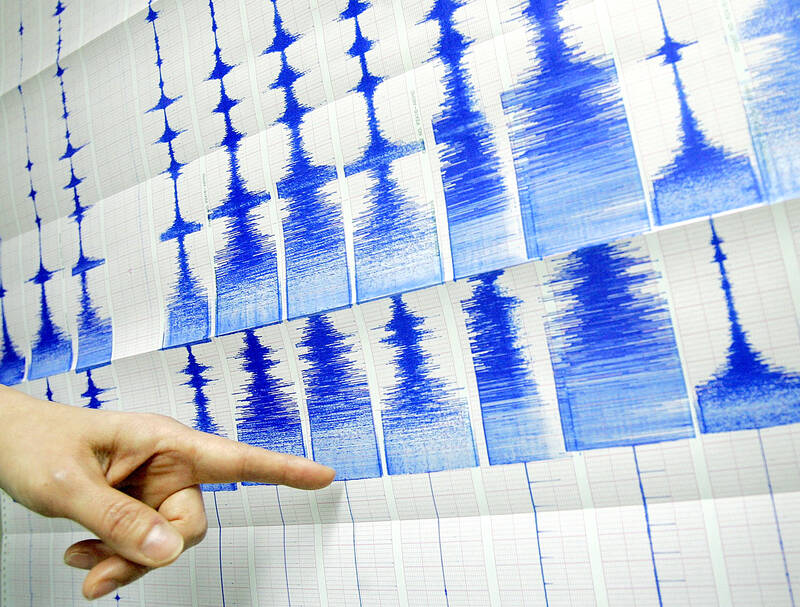The National Center for High-Performance Computing (NCHC) and Academia Sinica have developed an artificial intelligence (AI) model that could help researchers predict earthquakes one day in advance.
The model could predict earthquakes based on precursors to tectonic activity, researchers said.
The research team, led by Academia Sinica researcher Lee Lou-chuang (李羅權) and NCHC associate researcher Tsai Tsung-che (蔡宗哲), developed an AI model using total electron content (TEC) data and the Taiwania 2 supercomputer.

Photo: Jameson Wu, Reuters
The model could predict a magnitude 6 or higher earthquake one day in advance by analyzing data from the previous 30 days, they said.
Past studies also found that atmospheric TEC within a 50km radius of the epicenter of an earthquake show signs of change prior to a large earthquake, the Central Weather Bureau’s Seismological Center said, adding that TEC above Taiwan proper was low just before the 1999 Jiji earthquake.
National Taiwan University researcher Jhuang, Hau-Kun (莊皓琨), who was also on the research team, on Saturday said the team analyzed TEC data from Europe spanning 2003 to 2014.
“By filtering out certain information such as the disturbance storm time index, sunspot data and the solar radiation index, we were able to accurately determine hourly TEC changes,” he said.
The team also used data from 19 cases of TEC changes in which an earthquake did not occur to improve the accuracy of the AI model, he said.
“The system can now predict when a magnitude 6 or higher earthquake will occur, but we are still limited by the resolution of ionospheric data, and we cannot say for sure where the epicenter will be,” he said.
“We also have to work with a data transmission delay of five days or so, since our global ionospheric data are provided by Europe,” he added.
The team also found that the concentration of radon levels in the ground changes before a major earthquake, Academia Sinica researcher Fu Ching-chou (傅慶州) said, adding that the level of change increases with the earthquake’s intensity and proximity to the epicenter.
“We hope that through all of these factors we will be able to determine more accurately when a major quake will occur, so that we can notify people and ensure their safety,” he said.
The team’s findings have been published by the journal Earth and Space Science.

Trips for more than 100,000 international and domestic air travelers could be disrupted as China launches a military exercise around Taiwan today, Taiwan’s Civil Aviation Administration (CAA) said yesterday. The exercise could affect nearly 900 flights scheduled to enter the Taipei Flight Information Region (FIR) during the exercise window, it added. A notice issued by the Chinese Civil Aviation Administration showed there would be seven temporary zones around the Taiwan Strait which would be used for live-fire exercises, lasting from 8am to 6pm today. All aircraft are prohibited from entering during exercise, it says. Taipei FIR has 14 international air routes and

The Ministry of National Defense (MND) today released images of the military tracking China’s People's Liberation Army (PLA) movements during the latest round of Chinese drills around Taiwan. The PLA began "Justice Mission 2025" drills today, carrying out live-fire drills, simulated strikes on land and maritime targets, and exercises to blockade the nation's main ports. The exercises are to continue tomorrow, with the PLA announcing sea and air space restrictions for five zones around Taiwan for 10 hours starting from 8:30am. The ministry today released images showing a Chinese J-16 fighter jet tracked by a F-16V Block 20 jet and the

City buses in Taipei and New Taipei City, as well as the Taipei MRT, would on Saturday begin accepting QR code payments from five electronic payment providers, the Taipei Department of Transportation said yesterday. The new option would allow passengers to use the “transportation QR code” feature from EasyWallet, iPass Money, iCash Pay, Jkopay or PXPay Plus. Passengers should open their preferred electronic payment app, select the “transportation code” — not the regular payment code — unlock it, and scan the code at ticket readers or gates, General Planning Division Director-General Liu Kuo-chu (劉國著) said. People should move through the

Snow fell on Yushan (Jade Mountain, 玉山) yesterday morning as a continental cold air mass sent temperatures below freezing on Taiwan’s tallest peak, the Central Weather Administration (CWA) said. Snowflakes were seen on Yushan’s north peak from 6:28am to 6:38am, but they did not fully cover the ground and no accumulation was recorded, the CWA said. As of 7:42am, the lowest temperature recorded across Taiwan was minus-5.5°C at Yushan’s Fengkou observatory and minus-4.7°C at the Yushan observatory, CWA data showed. On Hehuanshan (合歡山) in Nantou County, a low of 1.3°C was recorded at 6:39pm, when ice pellets fell at Songsyue Lodge (松雪樓), a